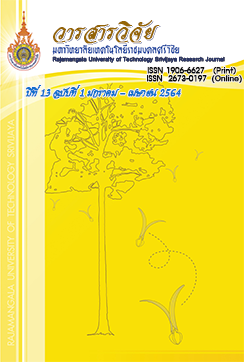Trans Fatty Acids Content in Non-dairy Cream, Margarine and Shortening Products Distributed in Pattani Province
Keywords:
Trans fatty acids, partially hydrogenated oil, shortening, margarine, non-dairy creamAbstract
Trans fatty acids (TFAs) are formed by the partial hydrogenation process of unsaturated fat. The Ministry of Public Health issued the announcement no. 388 B.E. 2561, specifying that partially hydrogenated oils and foods containing partially hydrogenated oils are prohibited to be manufactured, imported or sold. The objective of this research was to analyze the content of trans fatty acids in some hydrogenated products that were sold before and after the announcement.Samples were categorized into 3 groups; non-dairy cream, margarines and shortening. Before the announcement 14 samples of non-dairy cream, 18 samples of margarines and 2 samples of shortening products were collected. The fat in samples were extracted by solvent and had 98.38±0.27% recovery. It was found that trans fatty acids determined by gas chromatography in non-dairy cream, margarines and shortening were
0.06-2.81, 0.01-0.50 and 0.00-0.01 grams per serving, respectively. The sample that had trans fatty acid higher than the amount prescribed by the FDA, which is more than 0.5 grams per serving size found 1 product. It was shortening SH02 which had trans fatty acids 2.81 ± 0.09 grams per serving.The main types of trans fats were
trans-Octadecenoic acid (C18:1t). Sampling of products sold after the announcement of January 9, 2019, and a different number produced (lot number) from the samples collected before the announcement were 10samples of non-dairycream, 6 samples of margarine and 1 sample of shortening. No trans fatty acid content was found in non-dairy cream and shortening products. Margarine products contain trans-fatty acid content 0.00-0.01 grams per serving. Many samples had the trans fatty acids decreased but the content of saturated fatty acids increased. The trans fat in the shortening SH02 (same batch as collected sample before the announcement) was 3.18 ± 0.19 grams per serving, violated the criteria announced by the Ministry.
References
Abramovi, č.H., Vidrih, R., Zlati, ć.E., Kokalj, D., Schreiner, M., Žmitek, K., Kušarc, A. and Pravst, I. 2018. Trans fatty acids in margarines and shortenings in the food supply in Slovenia. Journal of Food Composition and Analysis 74: 53-61.
Chen, Y., Yang, Y., Nie, S., Yang, X., Wang, Y., Yang, M., And Xie, M. 2014. The analysis of trans fatty acid profiles in deep frying palm oil and chicken fillets with an improved gas chromatography method. Food Control 44: 191-197.
Costa, N., Cruz, R., Graça, P., Breda, J. and Casal, S. 2016. Trans fatty acids in the Portuguese food market. Food Control 64: 128-134.
Department of Disease Control. 2019. Number and rates of patient in 2017-2019 (High blood pressure, Diabetes, Corona artery disease, Stroke). Available Source: http://
www.thaincd.com/2016/mission/documents-detail.php?id=13684&tid=32&gid=1-020, December 16, 2019. (in Thai)
Food and Drug Administration. 2015. The FDA Takes Step to Remove Artificial Trans Fats in Processed Foods. Available source: https://
www.fda.gov/NewsEvents/Nwsroom/PressAnnouncements/ucm451237.htm, September 15, 2018.
Gu, Y. and Yin, J. 2020. Saturated fatty acids promote cholesterol biosynthesis: Effects and mechanisms. Obesity Medicine 18: 1-4.
Kim, S.H., Chunawala, L., Linde, R. and Reaven, G.M. 2006. Comparison of the 1997 and 2003 American Diabetes Association Classification of impaired fasting glucoseimpact on prevalence of impaired fasting glucose, coronary heart disease risk factors, and coronary heart disease in a community-based medical practice. Journal of the American College of Cardiology 48(2): 293-297.
Lepage, G. and Roy, C.C. 1984. Improved recovery of fatty acid through direct transesterification without prior extraction or purification. The Journal of Lipid Research 25: 1391-1396.
Ministry of Public Health. 1998. Ministry of public health notification No. 182 B.E.
(1998) Food labelling. Available Source: http://www.ratchakitcha.soc.go.th/
DATA/PDF/2541/D/047/23.PDF, September 8, 2018. (in Thai)
Ministry of Public health. 2018. Manual of Ministry of public health notification No. 388 B.E.
(2018) Prescribed prohibited food to be produced, imported or sold. Available Source: http://www.fda.moph.go.th/sites/food
/FileNews/manual_388.pdf, September 8, 2018. (in Thai)
Mozaffarian, D, ketan, M.B. Ascherio, A., Stampfer, M.J. and Willett, W.C. 2006. Trans fatty acids and cardiovascular disease. The New England Journal of Medicine 354(15): 1601-1613.
National Bureau of Agricultural Commodity and Food Standards. 2018. The World Health Organization issues a law to regulate trans fat. Available Source: https://
warning.acfs.go.th/ th/early-warning/view/?page=6294, September 15, 2018. (in Thai)
Oomen, C.M., Ocké, M.C., Feskens, E.J.M., Van Erp-Baart, M.A.J., Kok, F.J. and Kromhout, D. 2001. Association between trans fatty acid intake and 10-year risk of coronary heart disease in the Zutphen Elderly Study: A prospective population-based study. The Lancet 357: 746-751.
Downloads
Published
How to Cite
Issue
Section
License
The content and information in the article published in Journal of Rajamangala University of Technology Srivijaya It is the opinion and responsibility of the author of the article. The editorial journals do not need to agree. Or share any responsibility.







